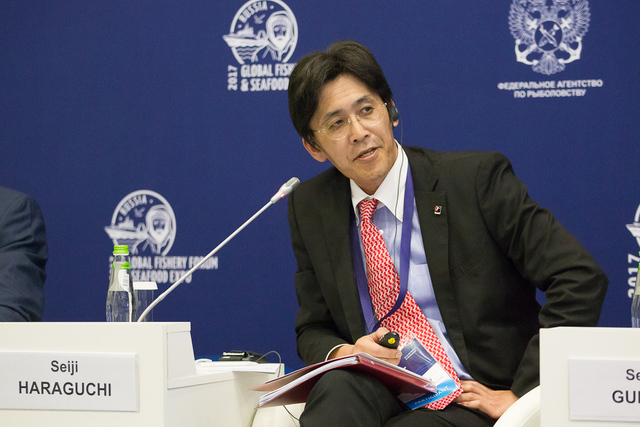2018年05月09日
スペイン科学技術財団 https://www.eurekalert.org/
抜粋サマリー仮訳 北海道機船漁業協同組合連合会 原口聖二
[パンガシウスの継続的な摂取は危険な水銀レベルになる]
ヴェトナム産のパンガシウス(Pangasius hypophthalmus)は低価格で、やわらかな香り、スキンレスの骨取りフィレのプレゼンテーションをもって、消費を拡大させ世界で最も消費される魚の一つとなっている。
学校、介護施設の給食、外食等で必要とされてきたが、スペインの科学者チームが実施した毒物学的評価では、いくつかのサンプル中の水銀含有量が、限度を超えていることが示されているため、特に若年者集団に、他の魚の摂取を推奨している。
パンガシウスはタンパク質含量がさほど高くなく、オメガ3のレベルも低い。
しかし、パンガシウスに関する懸念は、その栄養面ではなく、高濃度の水銀である。
この魚は、世界最長の支流の一つであるヴェトナムのメコン川や、米作物に使用される農薬やその他の化学物質等、人間活動により最も汚染されたものの一つである。
世界保健機関(WHO)を含めいくつかの報告によると、最終捕食者が最も汚染されることになるが、パンガシウスは水銀等の高濃度の金属を蓄積する傾向がある。
パンガシウスを食べることから生じる水銀による毒性リスクを評価するために、カナリア諸島の研究者チームは、3つの異なる広域の消費者が利用可能な冷凍フィレの計80サンプルを分析した。
“限界を超える水銀”
科学誌“Chemosphere”に掲載されたこの研究の結果は、いくつかのサンプルが欧州の法律で定められた最大許容濃度の0.5mg /kgを上回っていることを明らかにしている。
研究者らは、最大許容濃度を超え、継続的に摂取した人、とりわけ若年者に水銀蓄積による健康リスクが存在する可能性があると結論づけ、パンガシウスの代わりに他の魚を摂取することを勧めている。
その理由は、その栄養的貢献が低いからである。
Public Release: 7-May-2018
Continuous consumption of pangasius exposes to dangerous mercury levels
The pangasius, originally from Vietnam, is one of the most consumed fish in the world for its low cost, mild flavor and fillet presentation without skin or thorns. It is especially requested in school canteens and senior centers. But the toxicological evaluation carried out by a team of Spanish scientists now shows that the mercury content in some samples exceeds all limits, so the consumption of other fish in the child population is recommended.
Despite its low protein content and its even lower level of omega-3, the pangasius (Pangasius hypophthalmus) is one of the most consumed fish in the world, especially in Europe. Its low cost, its good flavor and a commercial presentation in the form of fillet without skin or thorns have increased its consumption, especially in schools, senior centers, the hotel sector and homes.
However, the concern with the Pangasius hypophthalmus is not really its nutritional profile, but its high concentration of mercury. The fish comes from the Mekong River in Vietnam, one of the longest tributaries in the world and also one of the most polluted due to the presence of pesticides and other chemical compounds used in rice crops, or human activities such as deforestation.
As a consequence, the animal itself, an omnivorous fish and a final predator, is also highly contaminated, according to several reports, including one from the World Health Organization. Pangasius hypophthalmus tends to accumulate higher concentrations of metals such as mercury.
"The consumption of this fish could expose the share of the population most sensitive to different contaminants that could be in this species," explains Ángel J. Gutiérrez Fernández, professor of the Toxicology Department at the University of La Laguna, to Sinc.
To assess the toxic risk due to mercury that could result from eating pangasius, a team of researchers from the Canary Islands has analyzed a total of 80 samples of frozen fillets stored in three different large areas and available to the consumer in natural or marinated.
Mercury limits exceeded
The results of the study, published in the Chemosphere journal, reveal that some specimens, especially in their marinated presentations, exceed the maximum admissible concentrations set by European legislation at 0.5 mg / kg (Regulation (EC) Nr. 1881/2006 of the Commission, of December 19, 2006), establishing the maximum content of certain contaminants in food products.
"It is necessary to exhaustively control the mercury content in this type of fish," says the researcher. The analysis, performed by cold vapor atomic absorption spectrophotometry, shows a wide range of mercury concentrations between 0.10-0.69 mg / kg, with average value of 0.22 mg / kg.
According to the researchers, although there were no significant differences between supermarkets, the average concentration of mercury in the marinade presentation (0.18 mg / kg) was higher than that obtained in the natural pangasius (0.16 mg / kg).
"Once these data have been obtained and assuming a weekly consumption of 350 grams of pangasius, the percentage of contribution to the Tolerable Weekly Intake (TWI) of mercury (4 μg / kg bw / week) is 32% and 27.5% for women and men, respectively, "says Gutiérrez.
The researchers conclude that in cases where the maximum permitted concentration is exceeded and after continued consumption there may be a health risk due to the accumulation of mercury in adults and, above all, in children. For the latter, they recommend the consumption of other fish instead of pangasius, also because of its low nutritional contribution.
###
Reference:
María Rodríguez et al. "Assessment of mercury content in Panga (Pangasius hypophthalmus)" Chemosphere 2018
Assessment of mercury content in Panga (Pangasius hypophthalmus).
- 1
- Department of Toxicology, University of La Laguna, La Laguna, Tenerife, Canary Islands, 38071, Spain.
- 2
- Department of Toxicology, University of La Laguna, La Laguna, Tenerife, Canary Islands, 38071, Spain. Electronic address: ajguti@ull.es.
- 3
- Canary Health Service, Las Palmas de Gran Canaria, 35004, Spain.
- 4
- Departament of Physical Medicine and Pharmacology, University of La Laguna, Tenerife, Canary Islands, 38071, Spain.
Abstract
Panga (Pangasius hypophthalmus), originating from Vietnam, is one of the most consumed fish because of its low cost, mild taste and presentation (fillets without skin and bones). Nevertheless, due to the high levels of contamination of the rivers where it lives, and to the fact that the panga is a predator, whereby it will accumulate a higher mercury concentration, the main objectives of the present study were to evaluate the toxic risk from mercury ingestion as a result of the consumption of this fish. A total of 80 frozen panga samples natural and marinade from different commercial establishments have been analyzed using cold vapour atomic absorption spectrophotometry (CV-AAS). The results obtained show a wide range of mercury concentrations between 0.10 and 0.69 mg/kg, with an average value of 0.22 mg/kg. In addition, it has been found that the average mercury concentration in the marinated presentation (0.18 mg/kg) is higher than that obtained in the natural panga (0.16 mg/kg). However, no significant differences were found between commercial establishments or in the presentation formats, with the conclusion that they did not influence the mercury content in the samples. Assuming a weekly consumption of 350 g of panga, the contribution rate to Tolerable Weekly Intake (TWI) of mercury (4 μg/kg bw/week) is 32% and 27.5% for women and men, respectively. Based on the results obtained in this study, an exhaustive control of the mercury content in this type of fish is necessary. In addition, a consumption restriction to children will be established.

















